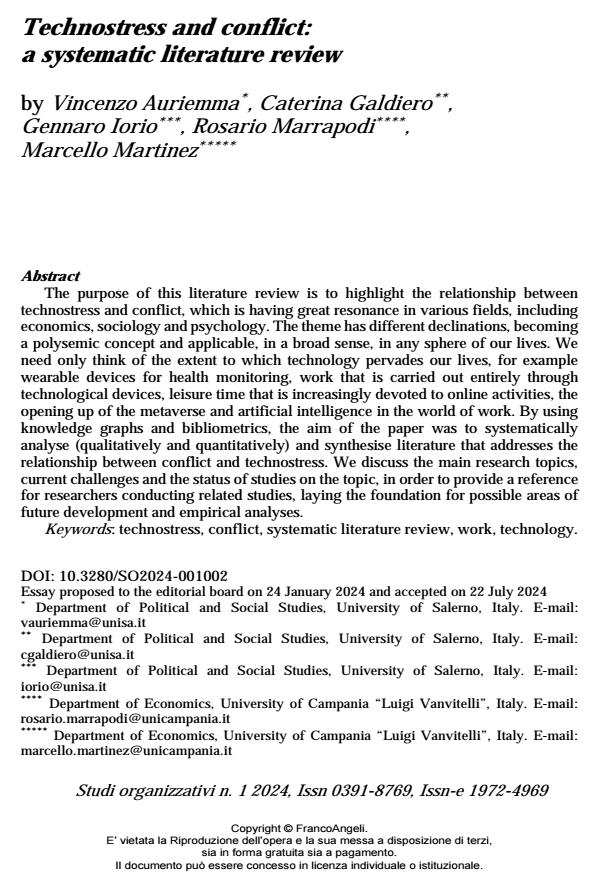Technostress and conflict: a systematic literature review
Titolo Rivista STUDI ORGANIZZATIVI
Autori/Curatori Vincenzo Auriemma, Caterina Galdiero, Gennaro Iorio, Rosario Marrapodi, Marcello Martinez
Anno di pubblicazione 2024 Fascicolo 2024/1
Lingua Inglese Numero pagine 31 P. 44-74 Dimensione file 590 KB
DOI 10.3280/SO2024-001002
Il DOI è il codice a barre della proprietà intellettuale: per saperne di più
clicca qui
Qui sotto puoi vedere in anteprima la prima pagina di questo articolo.
Se questo articolo ti interessa, lo puoi acquistare (e scaricare in formato pdf) seguendo le facili indicazioni per acquistare il download credit. Acquista Download Credits per scaricare questo Articolo in formato PDF

FrancoAngeli è membro della Publishers International Linking Association, Inc (PILA)associazione indipendente e non profit per facilitare (attraverso i servizi tecnologici implementati da CrossRef.org) l’accesso degli studiosi ai contenuti digitali nelle pubblicazioni professionali e scientifiche
The purpose of this literature review is to highlight the relationship between technostress and conflict, which is having great resonance in various fields, including economics, sociology and psychology. The theme has different declinations, becoming a polysemic concept and applicable, in a broad sense, in any sphere of our lives. We need only think of the extent to which technology pervades our lives, for example wearable devices for health monitoring, work that is carried out entirely through technological devices, leisure time that is increasingly devoted to online activities, the opening up of the metaverse and artificial intelligence in the world of work. By using knowledge graphs and bibliometrics, the aim of the paper was to systematically analyse (qualitatively and quantitatively) and synthesise literature that addresses the relationship between conflict and technostress. We discuss the main research topics, current challenges and the status of studies on the topic, in order to provide a reference for researchers conducting related studies, laying the foundation for possible areas of future development and empirical analyses.
Lo scopo di questa rassegna della letteratura è mettere in evidenza la relazione tra tecnostress e conflitto, che sta avendo grande risonanza in vari campi, tra cui l'economia, la sociologia e la psicologia. Il tema ha diverse declinazioni, diventando un concetto polisemico e applicabile, in senso lato, in qualsiasi ambito della nostra vita. Basti pensare a quanto la tecnologia pervade le nostre vite, attraverso ad esempio i dispositivi indossabili per il monitoraggio della salute, il lavoro che si svolge interamente attraverso dispositivi tecnologici, il tempo libero sempre più dedicato all'online, l'apertura al metaverso e alle intelligenze artificiali nel mondo del lavoro. Utilizzando i grafici della conoscenza e la bibliometria per analizzare (qualitativamente e quantitativamente) e sintetizzare sistematicamente la letteratura in questo campo, questo articolo analizza lo stato dell’arte della relazione tra conflitto e tecnostress. L’articolo fornisce un riferimento utile ai ricercatori che conducono studi in questo campo e pone le basi per possibili aree di sviluppo e analisi empiriche future.
Parole chiave:tecnostress, conflitto, revisione sistematica della letteratura, lavoro, tecnologia
Vincenzo Auriemma, Caterina Galdiero, Gennaro Iorio, Rosario Marrapodi, Marcello Martinez, Technostress and conflict: a systematic literature review in "STUDI ORGANIZZATIVI " 1/2024, pp 44-74, DOI: 10.3280/SO2024-001002